ChessProblems.ca Originals
2010 Tourney: T21-30
Compositions:
Main Page | T1-10 | T11-20 | T31-40 | T41-50 | T51-60 | T61-70 | T71-80
HC1-10 | HC11-20 | HC21-30 | HC31-40 | HC41-50 | HC51-60 | HC61-70
| # | Problem | Solution |
|---|---|---|
| T30 | Miodrag Mladenović & Arno Tüngler Serbia & Germany T30 ChessProblems.ca, 27.12.2010 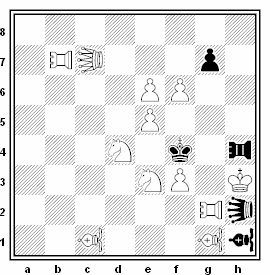 ser-h!= 148 C+ (12+5) C+ Circe Sirene c7, h2, Triton b7, g2, h4, Nereďde c1, g1, h1 |
Solution: 1.g7-g6 18.Kb1*c1 [+wNDc8] 27.Kb8*c8 36.Kf4*e3 58.Kf1*g1 [+wNDg8] 75.Kf8*g8 81.Ke3*d4 [+wSg1] 104.Kf1*g1 126.Kf4*f3 [+wPf2] 127.Kf3-e2 128.NDh1*g2-f3 [+wTRg8] 129.Ke2*f2 135.Kh7*g8 140.Kc8-b8 141.NDf3*b7-a8 142.NDa8-c6 143.Kb8*c7 [+wSIc8] 144.Kc7*c8 146.NDd5*e6-f7 [+wPe2] 148.Kd7-e6 e2-e4 !=
Miodrag Mladenović 4th Place A1 ifaybish.com TT6 2010 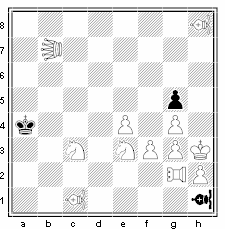 ser-h!= 118 (11+3) C+ Circe
Ralf Krätschmer 1st Place A1 ifaybish.com TT6 2010 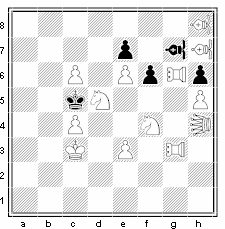 ser-h= 146 (13+5) C+ Circe |
| T29 | Bojan Bašić Serbia T29 ChessProblems.ca, 19.12.2010 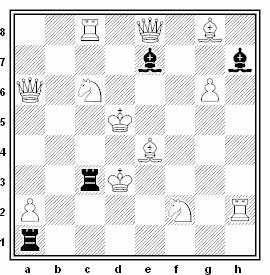 ser-s+ 10 (12+4) Extinction Chess, No White Captures |
Solution: 1.Qe8-f7 2.Rc8-f8 3.Sc6-d8 4.Qa6-f6 5.Kd5-d6 6.Qf7-b3 7.Kd3-c4 8.Be4-b1 9.Sf2-d3 10.Rh2-c2 Ra1*a2, Ra1*b1, Rc3*b3, Rc3*c2, Rc3*c4, Rc3*d3, Bh7*g6, Bh7*g8, Be7*f6, Be7*f8, Be7*d6, Be7*d8 +
|
| T27 | Ivan Skoba Czech Republic T27 ChessProblems.ca, 17.10.2010 (Version 08.05.2011) Position a: 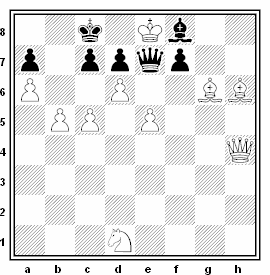 Position b: 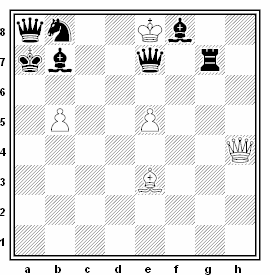 ser-ha=>b 35 (10+7) C+ Madrasi |
Solution: 1.f7-f5 2.Kc8-b8 6.f2-f1=R 7.Rf1*d1 8.Rd1*d6 9.Rd6*a6 10.Ra6*g6 11.a7-a5 12.Kb8-a7 16.a2-a1=S 17.Sa1-b3 18.Sb3*c5 19.Sc5-a6 20.c7-c5 21.Sa6-b8 25.c2-c1=Q 26.Qc1-c6 27.Qc6-a8 28.d7-d5 29.Rg6-g7 33.d2-d1=B 34.Bd1-f3 35.Bf3-b7 Bh6-e3 a=>b
|
| T26 | Ralf Krätschmer Germany T26 ChessProblems.ca, 13.10.2010  ser-h= 92 (13+3) C+ Circe Sirene c2, Triton a8, g7, Nereďde d1, d8, f1, f8 |
Solution: 13.Kg8*f8 31.Kb7*a8 51.Ke8*d8 69.Ka5*b6 [+wPb2] 70.Kb6*a7 [+wSg1] 82.Kg3*g2 83.Kg2*g1 85.Kh2*h3 [+wPh2] 86.Kh3-h4 87.NDf1-h3 88.NDh3-g4 90.Kg5-f6 91.NDg4-e6 92.NDe6-d5 Ke4*d5 =
|
| T25 | Ivan Skoba & Ján Golha Czech Republic & Slovakia T25 ChessProblems.ca, 05.10.2010  ser-h# 702 (3+1) C+ PWC Hole a8 b3 b4 b5 b6 c2 c6 c7 d2 d5 d8 e2 e4 e8 f2 f7 g2 g3 g4 g5 g6 h1 h8 |
Solution: 19.Kh4*h5 [+wPh4] 21.Kh6*h7 [+wPh6] 41.Kh3*h4 [+wPh3] 43.Kh5*h6 [+wPh5] 63.Kh2*h3 [+wPh2] 65.Kh4*h5 [+wPh4] 85.Kg1*h2 [+wPg1] 87.Kh3*h4 [+wPh3] 107.Kf1*g1 [+wPf1] 109.Kh2*h3 [+wPh2] 129.Ke1*f1 [+wPe1] 131.Kg1*h2 [+wPg1] 151.Kd1*e1 [+wPd1] 153.Kf1*g1 [+wPf1] 173.Kc1*d1 [+wPc1] 175.Ke1*f1 [+wPe1] 195.Kb1*c1 [+wPb1] 197.Kd1*e1 [+wPd1] 217.Ka2*b1 [+wPa2] 219.Kc1*d1 [+wPc1] 239.Ka3*a2 [+wPa3] 241.Kb1*c1 [+wPb1] 261.Ka4*a3 [+wPa4] 263.Ka2*b1 [+wPa2] 283.Ka5*a4 [+wPa5] 285.Ka3*a2 [+wPa3] 305.Ka6*a5 [+wPa6] 307.Ka4*a3 [+wPa4] 328.Ka7*a6 [+wPa7] 330.Ka5*a4 [+wPa5] 352.Ka6*a7 [+wPa6] 374.Ka4*a5 [+wPa4] 375.Ka5*a6 [+wPa5] 396.Ka3*a4 [+wPa3] 397.Ka4*a5 [+wPa4] 418.Ka2*a3 [+wPa2] 419.Ka3*a4 [+wPa3] 440.Kb1*a2 [+wPb1] 441.Ka2*a3 [+wPa2] 462.Kc1*b1 [+wPc1] 463.Kb1*a2 [+wPb1] 484.Kd1*c1 [+wPd1] 485.Kc1*b1 [+wPc1] 506.Ke1*d1 [+wPe1] 507.Kd1*c1 [+wPd1] 528.Kf1*e1 [+wPf1] 529.Ke1*d1 [+wPe1] 550.Kg1*f1 [+wPg1] 551.Kf1*e1 [+wPf1] 572.Kh2*g1 [+wPh2] 573.Kg1*f1 [+wPg1] 594.Kh3*h2 [+wPh3] 595.Kh2*g1 [+wPh2] 616.Kh4*h3 [+wPh4] 617.Kh3*h2 [+wPh3] 638.Kh5*h4 [+wPh5] 639.Kh4*h3 [+wPh4] 660.Kh6*h5 [+wPh6] 661.Kh5*h4 [+wPh5] 682.Kh7*h6 [+wPh7] 683.Kh6*h5 [+wPh6] 702.Ke7-f8 Bd4-c5 #
|
| T24 | Arno Tüngler Germany Sonja gewidmet zu unserem 22. Hochzeitstag am 24. September 2010 T24 ChessProblems.ca, 24.09.2010 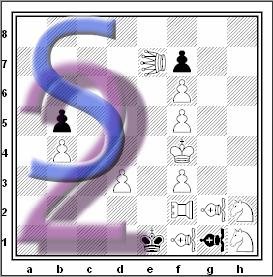 ser-h= 102 (12+4) C+ Circe Sirene e7, Triton f2, Nereďde f1, g2, g1 |
Solution: 1.Ke1-d1 22.Kh4-h3 23.Kh3*h2 47.Ke1*f1 [+wNDf8] 64.Ke8*f8 72.Kh2*h1 [+wSb1] 90.Kd4*d3 [+wPd2] 94.Ke1*f2 [+wTRf8] 95.Kf2-f1 96.NDg1-f2 101.Kh4-h5 102.NDf2-h4 TRf8-h8 =
|
| T23 | Vlaicu Crisan & Cornel Pacurar Romania & Canada T23 ChessProblems.ca, 21.08.2010 (v) 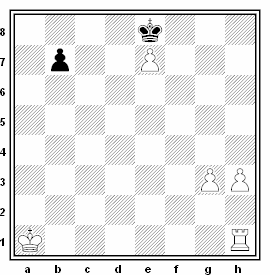 ser-h# 10 (5+2) C+ b) wPe7 -> h7, pser-h!= 10 Cage Circe |
Solutions: a) 1.Ke8*e7 [+wPe6] 2.Ke7*e6 [+wPe5] 3.Ke6*e5 [+wPe4] 4.Ke5*e4 [+wPe3] 5.Ke4*e3 [+wPe2] 6.Ke3*e2 [+wPe1] 7.Ke2-f3 8.Kf3*g3 [+wPa8=wB] 9.Kg3*h3 [+wPh2] 10.Kh3-g2 Ba8*b7 [+bPh3] # b) 1.b7-b5 2.b5-b4 3.b4-b3 4.b3-b2 + Ka1*b2 [+bPh4] 5.h4*g3 [+wPe7] 6.g3-g2 7.g2*h1=Q 8.Qh1*h3 [+wPe6] 9.Qh3*h7 [+wPe5] 10.Qh7-c2 + Kb2-a1 !=
|
| T22 | Radovan Tomašević Serbia T22 ChessProblems.ca, 06.08.2010 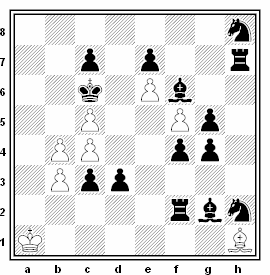 ser-# 88 (8+14) C+ b) Pg5->e5 ser-# 89 |
a) 5.Ke1*f2 22.Kg8*h7 41.Kg1*h2 63.Kh5*g4 84.Kf2*g2 86.Kf3-e4 87.Bh1-f3 88.Ke4*d3 # b) 5.Ke1*f2 22.Kg8*h7 41.Kg1*h2 63.Kh5*g4 84.Kf2*g2 85.Kg2-f3 88.Bf1*d3 89.Bd3-e4 #
|
| T21 | Zoran Sibinović Serbia T21 ChessProblems.ca, 04.08.2010  ser-# 117 (9+15) C+ |
1.Kf1-e1 5.Kb1-a1 6.Ba2-b1 18.Kg8*h8 22.Kh5*g4 36.Ka2-a1 37.Bb1-a2 43.Kf1*g1 49.Kb1-a1 50.Ba2-b1 65.Kg4*h3 80.Ka2-a1 81.Bb1-a2 88.Kg1*h1 95.Kb1-a1 96.Ba2-b1 111.Kg4*f3 112.Kf3-g4 114.f4*e5 115.Kg4*g5 116.Kg5-f4 117.Sh7-f8 #
|
